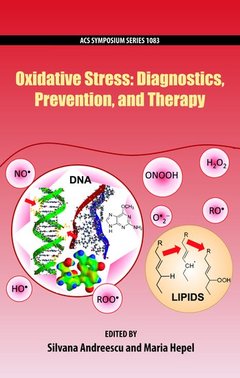Description
Oxidative Stress
Diagnostics, Prevention, and Therapy
ACS Symposium Series, Vol. 1083
Coordinators: Andreescu Silvana, Hepel Maria
Language: English
Subjects for Oxidative Stress:
Publication date: 07-2012
438 p. · 15.8x22.9 cm · Hardback
438 p. · 15.8x22.9 cm · Hardback
Description
/li>Contents
/li>Biography
/li>
Oxidative stress is the state of a diminished capacity of a biological system to counteract an overproduction or invasion of reactive oxygen species and other radicals. This book presents recent advancements in the understanding of oxidative stress, the mechanisms of damage to cells and biomolecules, and pathological implications in disorders including Alzheimer's disease, Parkinson's Disease, cardiovascular disease, cell damage in HIV-AIDS, stroke, autism and premature aging. The book is a comprehensive source of information describing new directions in diagnostics of oxidative stress, including novel detection methods of oxidative-stress biomarkers, prevention by antioxidants, and therapy using novel free radical scavenging agents and natural defense systems.
1. The Role of Antioxidants in Human Health. 2. Pathophysiological Implications of Altered Redox Balance in HIV/AIDS Infection: Diagnosis and Counteract Interventions. 3. Thermodynamics of Free Radical Reactions and the Redox Environment of a Cell. 4. Oxidative Stress in the Metabolism of Estrogens Leading to Cancer Initiation: Prevention by Specific Antioxidants. 5. Polyphenol Compounds as Antioxidants for Disease Prevention: Reactive Oxygen Species Scavenging, Enzyme Regulation, and Metal Chelation Mechanisms in E. coli and Human Cells. 6. DNA-Protective Mechanisms of Glutathione Intervention in Catechol-Mediated Oxidative DNA Damage in the Presence of Copper(II) Ions. 7. Antioxidant Effectiveness in Preventing Paraquat-Mediated Oxidative Dna Damage in the Presence of H2O2. 8. Artificial Nanoparticle Antioxidants. 9. Cerium Oxide Nanoparticles for the Treatment of Neurological Oxidative Stress Diseases. 10. Detection of Superoxide and Hydrogen Peroxide from Living Cells Using Electrochemical Sensors. 11. Peroxynitrite and Nitroxidative Stress: Detection Probes and Micro-Sensors. A Case of a Nanostructured Catalytic Film. 12. Blue Native PAGE and Mass Spectrometry as an Approach for the Investigation of Stable and Transient Protein-Protein Interactions. 13. Mass Spectrometry for Proteomics-Based Investigation of Oxidative Stress and Heat Shock Proteins.
Silvana Andreescu is Associate professor in the Department of Chemistry and Biomolecular Science at Clarkson University, Potsdam, NY. Her research expertise is in analytical and bioanalytical chemistry focusing on the development, characterization and application of chemical and biological sensors for clinical, food and environmental monitoring. She published more than 55 peer-reviewed journal articles and 11 book chapters, and delivered some 100 presentations at professional and academic conferences. Maria Hepel received the M.S. and Ph.D. degrees in chemistry from Jagellonian University in Krakow, Poland. From 1985 she worked as the Faculty at the State University of New York at Potsdam where she is now a Professor and Chair of the Department of Chemistry. She published over 140 papers, 25 chapters in books, and has made over 400 presentations at the national and international symposia.
© 2024 LAVOISIER S.A.S.




